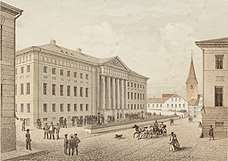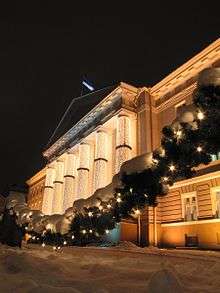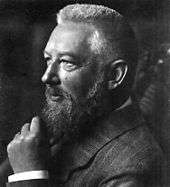University of Tartu
The University of Tartu (UT; Estonian: Tartu Ülikool, Latin: Universitas Tartuensis) is a university in the city of Tartu in Estonia. It is the national university of Estonia,[2] and the only classical university in the country,[3] and also the biggest[4] and most prestigious[5] university in Estonia. It was founded under the name of Academia Gustaviana in 1632 by Baron Johan Skytte, the Governor- General (1629–1634) of Swedish Livonia, Ingria and Karelia, with the required ratification provided by his long-time friend and former student – from age 7 –, King Gustavus Adolphus, shortly before the king's death on 6 November in the Battle of Lützen (1632),[6][7] during the Thirty Years' War (1618–1648).
Tartu Ülikool | |
 | |
| Latin: Universitas Tartuensis | |
Former names | Academia Gustaviana, University of Dorpat/Yuryev, Tartu State University |
|---|---|
| Type | Public |
| Established | 1632 (closed 1710–1802) |
| Rector | Toomas Asser |
Academic staff | 1,700 |
Administrative staff | 1,800 |
| Students | 13,169 (2018)[1] |
| Undergraduates | 7,953 (2018)[1] |
| Postgraduates | 4,033 (2018)[1] |
| 1,183 (2018)[1] | |
| Location | , 58°22′52″N 26°43′13″E |
| Campus | Urban (University town) |
| Colours | Blue White |
| Nickname | UT |
| Affiliations | CBUR, EUA, Coimbra Group, Utrecht Network, Atomium Culture Guild of European Research-Intensive Universities |
| Website | www |
Nearly 14,000 students are at the university, of whom over 1,300 are foreign students.[1] The language of instruction in most curricula is Estonian, some more notable exceptions are taught in English, such as semiotics, applied measurement science, computer science, information technology law, and European Union – Russia studies.[8]
The historical buildings of the university are included in the European Heritage Label list as "embodiment of the ideas of a university in the Age of Enlightenment".[9] The university is a member of the Coimbra Group and the Utrecht Network.[10]
History
Academia Gustaviana
The Academia Gustaviana in the then-Swedish province of Livonia was the second university founded in the Swedish Empire, following Uppsala University (in Uppsala, Sweden proper) and preceding the Academy of Åbo (in Turku, Finland). A precursor to the academy had been a Jesuit grammar school Gymnasium Dorpatense, founded by Stefan Batory (then king of Poland–Lithuania) in 1583 and existing to 1601, when Tartu (Dorpat) was under Polish–Lithuanian rule.
The first students matriculated between 20 and 21 April 1632. The opening ceremony of Academia Dorpatensis (Academia Gustaviana) took place on 15 October in the same year. The academy in Tartu functioned with philosophy, law, theology, and medical faculties enjoying the privileges of the University of Uppsala. On account of the Russian–Swedish war, the University of Tartu moved to Tallinn in 1656, and in 1665, it closed down. In the 17th century, the future outstanding Swedish scholars Urban Hiärne, Olof Verelius, Arvid Moller, and others studied at the university. Among the academic staff were Friedrich Menius, professor of history (the history of Livonia, the first scientific approach to Estonian folklore) and Georg Mancelius, professor of theology (author of the first Latvian-German dictionary in 1638[11]).
With the reestablishment of the university in 1690 as the Academia Gustavo-Carolina, Tartu became a university town again. Academic staff of the new university included Sven Dimberg, professor of mathematics (the first in the world to deliver lectures based on Newton's theory), Olof_Hermelin, professor of rhetoric and poetry, Lars Micrander, professor of medicine (founder of balneology, and discoverer of natural mineral water springs) and Michael Dau, professor of philosophy as well as of rhetoric and poetry. Just under a decade after being reconstituted, as a result of the coalition against Sweden (Russia, Denmark-Norway, and Saxony-Poland-Lithuania) and the Great Famine of 1695–1697, the university moved from Tartu to Pärnu. Eventually, Academia Gustavo-Carolina, which had opened in Pärnu on 28 August 1699, was closed as a result of the surrender of Pärnu to Russian forces on 12 August 1710 during the Great Northern War. According to the terms of the capitulation, the Russians agreed to maintain the university in Pärnu.[12] However, the university was only reopened in 1802 by the Baltic German Ritterschaften, when the new German-speaking University was relaunched and had its new charter confirmed by the reform-minded Tsar Alexander I of Russia.[13]
Universität Dorpat

.jpg)
The university was reopened by the Baltic Germans in Estonia in April 1802. The language of instruction at Dorpat was German[13] from 1802 to 1893. During that time, Dorpat had a dual nature in that it belonged both to the set of German(-language) and Russian universities. Financially and administratively, the latter was more important; intellectually and regarding the professoriate and students, the former was more important (over half the professors came from Germany, at least another third were Baltic Germans). Among the 30 German-language universities, of which 23 were inside the German Empire, Dorpat was the 11th in size. In teaching, the university educated the local Baltic German leadership and professional classes, as well as staff, especially for the administration and health system of the entire Russian Empire. In scholarship, it was an international university; the time between 1860 and 1880 was its "golden age".
The freedom to be a half-German university ceased with the rise of nationalist tendencies in Russia, which held homogenization more important than retaining a bilingual university. Between 1882 and 1898, russification in language, appointments, etc., was imposed, with some exceptions (such as the Divinity School, which the state feared would be used by the Orthodox clergy to teach dangerous Protestant views and was thus allowed to continue in German until 1916). By 1898, when both the town and the university were renamed Yuryev, virtually all distinguished scholars from Germany had left. The University of Yuryev existed until 1918, when during part of the fall term, it was reopened, under German occupation, as Dorpat. Russian academic staff and students took refuge in Voronezh in Russia, giving rise to the foundation of Voronezh State University, which traces its own history back to the foundation of the University of Tartu and still holds several physical properties of the latter.
University of Tartu (1919–)
Since Estonia became independent in 1918, the University of Tartu has been an Estonian-language institution since 1919. The university was named Ostland-Universität in Dorpat during the German occupation of Estonia in 1941–1944 and Tartu State University (Estonian: Tartu Riiklik Ülikool) in 1940–1941 and 1944–1989, during the Soviet occupation. During Soviet rule, although Estonian remained the principal language of instruction, some courses were taught in Russian, with several Russian curricula. Estonia regained independence in 1991, and the full recovery of academic autonomy of the university can be dated to 1992. Presently, no courses are taught in Russian.[14]

The last decade has been marked by organizational and structural changes, as well as adaptations to various university models (American, Scandinavian, German) against the background of the Soviet and Baltic German past. Most recently, the university has been and is still being marked by the adaptation of the Bologna declaration in Estonia generally and Tartu specifically, leading to major changes in curricula and studies, as well as by strong organizational centralization attempts. Recent plans also include the abolition of the Chair system (an Americanization) and of the faculties, which is supposed to lead to four large divisions (humanities, social sciences, natural sciences, and medicine) under briefly serving deans and rector-appointed financial administrators.
Buildings
The university's four museums, its Botanical Gardens, and sports facilities are, by and large, open to the general public. The university possesses some 150 buildings, 30 of which are outside of Tartu. 31 of its buildings decorate the city as architectural monuments. However, the current reforms include attempts to sell, or have the state co-sponsor, several of these buildings and monuments, as well as sports facilities, as they are not seen as part of the university's mission proper.
At the same time, numerous university buildings and student dormitories have been recently constructed or renovated, such as the Von Bock House. Many of the new buildings are built to Maarjamõisa (about 2 km southwest of the historical university centre), such as the Technology Institute, the Biomedical Center, the Chemistry building, and the new Physics building.
 Tartu University main building during Christmas (2006)
Tartu University main building during Christmas (2006)- Faculty of Social Sciences
- Institute of Mathematics and Statistics
- University track and field
- Iuridicum, law building
- Chemicum and Physicum
Research

Lectinology, the science of lectins, was founded at the University of Tartu in 1888 with the publication of Peter Hermann Stillmark's thesis about the isolation of ricin.
According to the university administration, the most remarkable recent research achievements have been in the fields of molecular and cell biology, laser medicine, materials science, laser spectroscopy, biochemistry, and psychology.
UT is the flagship of Estonian science, ranking in the top 1% of the world’s most-cited universities and research institutions in the following ten fields (as of March 2018):
› Clinical Medicine
› Chemistry
› Environment & Ecology
› Geoscience
› Plant & Animal Science
› Social Sciences
› Molecular Biology & Genetics
› Biology & Biochemistry
› Neuroscience & Behaviour
› Psychiatry & Psychology.
UT accounts for 56% of Estonia’s national research output. Also, more than half of the PhD theses in Estonia are defended at UT and over 2,000 high-level research articles (those covered by citation indices like "SCI Expanded", "SSCI" or "A&HCI") are published annually. About 50 UT scientists are among the top 1% of the most-cited scientists in the world.
UT has excelled among the Baltic universities in winning European Research Council grants. The prestigious ERC grant has been awarded to Professor of Molecular Systems Biology Mart Loog, Professor of Nanomedicine Tambet Teesalu, and Professor of International Law Lauri Mälksoo.
Entrepreneurship
University of Tartu has contracts with 154 business partners in the amount of 10.2 million euros. UT is one of the largest development partners for the private and public sector in the Baltics. The university also works closely with international businesses such as Swedbank, The Linde Group, Pfizer, ABB Corporate Research, SUPER APPLI Inc, Eesti Energia Group, Telia AS, and many more.
UT has spun off more than 60 start-ups, including software companies Reach-U and Positium providing location-based solutions, biotechnology company Icosagen etc. The success story of the last 15 years is the technology for the ME-3 strain of Lactobacillus fermentum bacterium, allowing its use in the food industry. Student satellite ESTCube-1, developed collectively by UT staff and students, and successfully deployed into orbit in 2013, made Estonia the 41st space nation in the world. Scientists from UT and the Estonian University of Life Sciences have developed a new peat-based material that enables building inexpensive energy-efficient 3D-printed houses. The innovative robotic mannequin technology known as Rakuten Fits Me, a virtual dressing room, was originally developed in cooperation with researchers of UT Institute of Technology.
UT encourages its students and scholars to develop an entrepreneurial mindset and apply their knowledge to the economy. The University has set a goal to integrate entrepreneurship courses into every curriculum.
Structure
The academic structure[15] of the university consists of institutes and colleges of four faculties (valdkond).
While mainly located in Tartu, the university also operates in Narva, Pärnu, Tallinn, and Viljandi. Narva and Pärnu Colleges are part of the Faculty of Social Sciences, Viljandi Culture Academy belongs to the Faculty of Arts and Humanities. The School of Law Tallinn office, University of Tartu Tallinn representation and the Estonian Marine Institute are located in the Estonian capital.
| Faculty of Arts and Humanities | Faculty of Social Sciences | Faculty of Medicine | Faculty of Science and Technology |
|---|---|---|---|
| School of Theology and Religious Studies | School of Law | Institute of Biomedicine and Translational Medicine | Estonian Marine Institute |
| Institute of History and Archaeology | School of Economics and Business Administration | Institute of Family Medicine and Public Health | Institute of Physics |
| Institute of Estonian and General Linguistics | Institute of Social Studies | Institute of Pharmacy | Institute of Chemistry |
| Institute of Philosophy and Semiotics | Institute of Education | Institute of Clinical Medicine | Institute of Molecular and Cell Biology |
| Institute of Cultural Research and Arts | Institute of Psychology | Institute of Dentistry | Institute of Technology |
| College of Foreign Languages and Cultures | Johan Skytte Institute of Political Studies | Institute of Sport Sciences and Physiotherapy | Institute of Ecology and Earth Sciences |
| Viljandi Culture Academy | Narva College | Institute of Computer Science | |
| Pärnu College | Institute of Mathematics and Statistics | ||
| Tartu Observatory |
Studies
Nearly a quarter of the whole Estonian university student population studies at the University of Tartu.[16] While most of the curricula are taught in Estonian, a number of degree programmes have English as a medium of instruction.
35% of UT’s study courses are offered partly or fully online – as web-based courses in Moodle, video lectures, webinars, e-portfolios, massive open online courses (MOOCs).
56 bachelor’s and 72 master’s programmes are available, including 26 programmes in English.
Bachelor's studies
The university offers 56 different curricula on the bachelor's level, including the open university curricula.[17] Three bachelor's degree programmes out of 56 are fully taught in English:
Master's studies
University of Tartu has 72 study programmes on master's level.[21] These programmes include 24 international master's programmes in English:
Humanities
Social sciences
- Contemporary Asian and Middle Eastern Studies
- Educational technology[26]
- European Union – Russia studies[27]
- Democracy and governance[28]
- Information technology law[29]
- Innovation and technology management
- International law and human rights[30]
- International relations and regional studies[31]
- Quantitative economics[32]
- Wellness and spa service design and management[33]
Science and technology
Doctoral studies
Around 120 doctoral degrees are defended annually, which make up more than half of the total number in Estonia. The language of instruction for most of the PhD programmes (35) is English. Four programmes at least partly have Estonian as a medium of instruction. These programmes are: Estonian and Finno-Ugric Linguistics, Law, History and Pharmacy.[41]
In addition, over 45,000 learners enrolled in lifelong learning courses each year.
Rankings and reputation
| University rankings | |
|---|---|
| Global – Overall | |
| ARWU World[42] | 301-400 (2018) |
| THE World[43] | 301-350 (2019) |
| USNWR Global[44] | 322 (2019) |
| QS World[45] | 321 (2019) |
The QS World University Rankings ranked the University of Tartu 301st in the world in 2018, and the top-ranked university in the Baltics.[46] The university is also ranked 3rd in the Emerging Europe and Central Asia region.[47] The Times Higher Education World University Rankings placed it in the 301–350 range among world universities.[48] It is the only university in the Baltic countries to place among the top 200 universities in Europe.[49] UT belongs to top 1% of world's most cited universities in 10 research areas.[50]
Alumni
According to the university, as of 2016, Tartu alumni comprise 100% of Estonian judges; 99% of Estonian doctors, dentists, and pharmacists; 95% of Estonian judicial prosecutors; 87% of members of the Estonian Bar Association; 60% of the ministers in the Estonian government; and 40% of the members of the Riigikogu (Estonian Parliament).[51]
International cooperation
University of Tartu has around 1,200 international students from 90 countries. The vast majority comes from Russia, Finland and Ukraine. In the Erasmus programme for student exchange, the University of Tartu cooperates with more than 800 universities.
University has also received good reviews from foreign students and an International Student Satisfaction Award based on student feedback.[52]
The University of Tartu participates in the LERU-CE7 (LERU and a group of Central-European universities), the European University Association EUA, Coimbra Group, The Guild of European Research Intensive Universities and the Utrecht Network. It has signed bilateral co-operation agreements with about 70 universities[53]
See also
- List of early modern universities in Europe
- Tartu University Clinic
- Tartu University Library
- Tartu University Press
- Tartu Semiotic School
- Copenhagen-Tartu school
- Tartu Ülikool 350
- University of Tartu Old Observatory
- Tartu Students' Nature Conservation Circle
References
- Tartu Ülikool
- As stipulated by the § 2 (1) of the University of Tartu Act. University of Tartu Act Archived 27 May 2012 at Archive.today
- About the University University of Tartu
- Study in Estonia topuniversities.com
- "Tartu ülikool hoiab Eestis kõige mainekama ülikooli tiitlit" Tartu Postimees. 17 June 2015(in Estonian)
- Johan Skytte biography by David Lindén: Johan Skytte – stormaktstidens läromästare, Atlantis, 2017.
- Johan Skytte biography by Jenny Ingemarsdotter: Ramism, Rhetoric & Reform: An Intellectual Biography of Johan Skytte (1577-1645), Uppsala, 2011. ISBN 978-91-554-8071-4
- "Master's Degree Programmes Taught in English". www.ut.ee. 13 January 2006. Retrieved 23 January 2019.
- Culture: Nine European historical sites now on the European Heritage Label list European Commission, 8 February 2016
- "Opportunities for Studying Abroad as an Exchange Student". ut.ee. Retrieved 29 June 2017.
- "Lettus, das ist Wortbuch sampt angehengtem täglichem Gebrauch der Lettischen Sprache". Rīga, 1638. (Pilnais nosaukums [complete name]: "Lettus, Das ist Wortbuch Sampt angehengtem täglichem Gebrauch der Lettischen Sprache; Allen und jeden Ausheimischen die in Curland/Semgallen und Lettischen Liefflande bleiben und sich redlich nehren wollen zu Nutze verfertigt Durch GEORGIVM MANCELIVM Anno M. DC. XXXVIII").
- Sirje Tamul on History of Tartu University Archived 4 May 2008 at the Wayback Machine
- History, Tartu University. Retrieved 30 December 2013
- "Тартуский университет: мы предпочитаем принимать вступительные экзамены на эстонском языке". Postimees. 27 January 2014. Retrieved 9 February 2015.
- "Structure and Staff | University of Tartu". www.ut.ee. Retrieved 14 April 2016.
- "University of Tartu (booklet) 2016". Issuu. Retrieved 15 April 2016.
- "Õppekavad ja vastuvõtutingimused | Tartu Ülikool". www.ut.ee. Retrieved 15 April 2016.
- "Bachelor of Business Administration | University of Tartu". www.ut.ee. Retrieved 15 April 2016.
- "Science and Technology | University of Tartu". www.ut.ee. Retrieved 15 April 2016.
- "Medicine in English (6 years) | University of Tartu". www.ut.ee. Retrieved 15 April 2016.
- "Õppekavad ja vastuvõtutingimused | Tartu Ülikool". www.ut.ee. Retrieved 15 April 2016.
- "Master's Programme in Philosophy at the University of Tartu | University of Tartu". www.flfi.ut.ee. Retrieved 15 April 2016.
- "Master of Arts in Humanities – Semiotics | University of Tartu". www.flfi.ut.ee. Retrieved 15 April 2016.
- "Folkloristics and applied heritage studies | University of Tartu Institute for Cultural Research and Fine Arts". www.flku.ut.ee. Retrieved 2 January 2017.
- "European Languages and Cultures | College of Foreign Languages and Cultures of University of Tartu". www.maailmakeeled.ut.ee. Retrieved 2 January 2017.
- "Master's programme in Educational Technology | University of Tartu". www.ut.ee. Retrieved 2 January 2017.
- "European Union – Russia Studies | Johan Skytte Institute of Political Studies". skytte.ut.ee. Retrieved 15 April 2016.
- "Democracy and Governance | Johan Skytte Institute of Political Studies". skytte.ut.ee. Retrieved 15 April 2016.
- "Information Technology Law – Master of Arts in Law | Faculty of Law". www.oi.ut.ee. Retrieved 15 April 2016.
- "International Law and Human Rights | Faculty of Law". www.oi.ut.ee. Retrieved 15 April 2016.
- "International Relations and Regional Studies | Johan Skytte Institute of Political Studies". skytte.ut.ee. Retrieved 15 April 2016.
- "Master of Arts in Social Sciences – Quantitative Economics | University of Tartu". www.ut.ee. Retrieved 15 April 2016.
- "Wellness and Spa Service Design and Management – International Master's Programme in Pärnu, Estonia". wellnesseducation.pc.ut.ee. Retrieved 15 April 2016.
- "Master's programme in Actuarial and Financial Engineering | University of Tartu". www.ut.ee. Retrieved 14 November 2016.
- "Measurements, metrology and analytical chemistry master program | Applied Measurement Science". www.ut.ee. Retrieved 15 April 2016.
- "Masters in Computer Science". compsci.cs.ut.ee. Retrieved 15 April 2016.
- "Excellence in Analytical Chemistry". ut.ee. Retrieved 15 April 2016.
- "Geoinformatics for Urbanised Society (MSc) | Department of Geography". www.geograafia.ut.ee. Retrieved 2 January 2017.
- "Welcome to Robotics and Computer Engineering | Robotics and Computer Engineering". rce.tuit.ut.ee. Retrieved 15 April 2016.
- "Master of Science in Software Engineering". software.cs.ut.ee. Retrieved 15 April 2016.
- "Doctoral Studies | University of Tartu". www.ut.ee. Retrieved 18 April 2016.
- Academic Ranking of World Universities 2018
- "World University Rankings 2019 - Leiden University". Times Higher Education (THE). Retrieved 28 September 2018.
- U.S. News Education: Best Global Universities 2019
- QS World University Rankings 2019
- "University of Tartu achieves new record in the world rankings". Estonian World. 7 September 2016. Retrieved 23 January 2019.
- "QS University Rankings: EECA 2015". Top Universities. Retrieved 11 April 2016.
- University of Tartu Times Higher Education World University Rankings
- Best universities in Europe 2016 Times Higher Education, 10 March 2016
- TartuUniversity (2 January 2017), University of Tartu – Get Inspired!, retrieved 2 January 2017
- "University of Tartu (booklet) 2016". Issuu. Retrieved 18 April 2016.
- University of Tartu rated highly by international students ERR News, 28 Sep 2015
- "Partner Universities". University of Tartu. Retrieved 9 February 2015.
Bibliography
- Reet Mägi; Wolfgang Drechsler, eds. (2004). Kaiserliche Universität Dorpat 200, 370 Academia Gustaviana: Tartu Ülikooli juubel. Tartu: Tartu Ülikooli Kirjastus. ISBN 9985-56-950-4.
- Siilivask, Karl (ed.) (1985). History of Tartu University, 1632–1982. Tallinn: Perioodika.CS1 maint: extra text: authors list (link)
- Die Universitäten Dorpat/Tartu, Riga und Wilna/Vilnius 1579–1979. Beiträge zu ihrer Geschichte und ihrer Wirkung im Grenzbereich zwischen West und Ost. Herausgegeben von Gert von Pistohlkors, Toivo U. Raun, Paul Kaegbein. Köln; Wien 1987 (Quellen und Studien zur baltischen Geschichte; 9). [Zweites Internationales Marburger Symposium zu Problemen der baltischen Sozial- und Kulturgeschichte]. [Lectures in German and English] ISBN 3-412-00886-9
- Palamets, Hillar; Tullio Ilomets, eds. (1982). Alma mater Tartuensis: Tartu Riiklik Ulikool: 1632–1982 (in Estonian). Tallinn: Eesti Raamat.
- von Engelhardt, Roderich (1933). Die deutsche Universität Dorpat in ihrer geistesgeschichtlichen Bedeutung (in German). Reval (Tallinn): F. Kluge.
- Semel, Hugo (ed.) (1918). Die Universität Dorpat (1802–1918): Skizzen zu ihrer Geschichte von Lehrern und ehmaligen Schülern (in German). Dorpat (Tartu): H. Laakmann.CS1 maint: extra text: authors list (link)
Further reading
- David H. Stam, ed. (2001). "Tartu University Library". International Dictionary of Library Histories. Fitzroy Dearborn. ISBN 1579582443.
External links
| Wikimedia Commons has media related to University of Tartu. |
- Official website
- University of Tartu Official YouTube Channel